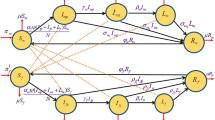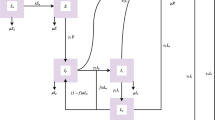Abstract
Globally, there is a high incidence of Syphilis among men who have sex with men (MSM). This is due to risk factors, such as having multiple partners, condomless sex, or substance abuse. In this paper, we present a mathematical model for Syphilis transmission dynamics among the MSM popion that incorporates high/low-risk transmission classes. The model equilibrium points and basic reproduction number (\(\mathcal {R}_{0}\)) are computed, and a bifurcation analysis is performed. Analytical results show that in the absence of infection-acquired immunity, the disease-free equilibrium is globally asymptotically stable when \(\mathcal {R}_{0}<1.\) Global sensitivity analysis was performed using the Latin-hypercube sampling technique to determine sensitive parameters. The results indicate that the most sensitive parameters are the high-risk transmission rate, progression rate from primary infection to secondary infection, human recruitment, and mortality rates. Results from numerical simulations suggest that increasing the Syphilis treatment rates and reducing high/low-risk infection rates is essential for controlling Syphilis spread in the MSM population. We envisage that our findings can serve as a tool for Syphilis risk assessment to help alleviate public health concerns associated with Syphilis transmission within the MSM population.











Similar content being viewed by others
References
Aldila D, Chavez JP, Wijaya KP, Ganegoda NC, Simorangkir GM, Tasman H, Soewono E (2023) A tuberculosis epidemic model as a proxy for the assessment of the novel M72/AS01E vaccine. Commun Nonlinear Sci Numer Simul 120:107162
Aldila D, Awdinda N, Herdicho FF, Ndii MZ, Chukwu CW (2023) Optimal control of pneumonia transmission model with seasonal factor: Learning from Jakarta incidence data. Heliyon 9(7)
Bissessor M, Fairley CK, Leslie D et al (2010) Frequent screening for Syphilis as part of HIV monitoring increases the detection of early asymptomatic Syphilis among HIV-positive homosexual men. J Acquir Immune Defic Syndr 55:211–6
Blower SM, Dowlatabadi H (1994) Sensitivity and uncertainty analysis of complex models of disease transmission: an HIV model, as an example. Int Stat Rev 229–243
Bonyah E, Chukwu CW, Juga ML, Fatmawati (2021) Modeling fractional-order dynamics of Syphilis via Mittag-Leffler law. AIMS Math 6(8):8367–8389
Branger J, van der Meer JTM, van Ketel RJ et al (2009) High incidence of asymptomatic Syphilis in HIV-infected MSM justifies routine screening. Sex Transm Dis 36:84–5
Castillo-Chavez C, Song B (2004) Dynamical models of tuberculosis and their applications. Math Biosci Eng 1(2):361–404
CDC, Mortality in the United States, 2021. https://www.cdc.gov/nchs/products/databriefs/db456.htm#:~:text=In%202021%2C%20life%20expectancy%20at,2020%20to%2079.3%20in%202021. Accessed 27 Nov 2023
Centers for disease control and prevention, men who have sex with men (MSM), https://www.cdc.gov/std/treatment-guidelines/msm.htm. Accessed 02 Oct 2024
Champredon D, Cameron CE, Smieja M et al (2016) Epidemiological impact of a Syphilis vaccine: a simulation study. Epidemiol Infect 144:3244–52
Chazuka Z, (2021) In-host model for the co-infection dynamics of high-risk human papillomavirus (HPV) and HIV in the presence of immune response
Chazuka Z, Mudimu E, Mathebula D (2024) Stability and bifurcation analysis of an HIV model with pre-exposure prophylaxis and treatment interventions. Sci Afr 23:e01979
Chukwu CW, Alqahtani RT, Alfiniyah C, Herdicho FF (2023) A Pontryagin’s maximum principle and optimal control model with cost-effectiveness analysis of the COVID-19 epidemic. Decis Anal J 100273
Chukwu CW, Mushanyu J, Juga ML (2020) A mathematical model for co-dynamics of listeriosis and bacterial meningitis diseases. Commun Math Biol Neurosci. pp.Article-ID
Chukwu CW, Juga ML, Chazuka Z, Mushanyu J (2022) Mathematical analysis and sensitivity assessment of HIV/AIDS-listeriosis co-infection dynamics. Int J Appl Comput Math 8(5):251
Colglazier W (2015) Sustainable development agenda: 2030. Science 349(6252):1048–1050
Division of STD Prevention, National Center for HIV, Viral Hepatitis, STD, and TB Prevention, Centers for Disease Control and Prevention. Page last reviewed. https://www.cdc.gov/std/syphilis/stdfact-syphilis.htm#:~:text=Primary%20Stage &text=The%20sore%20usually%20lasts%203,moving%20to%20the%20secondary%20stage. Accessed 27 Nov 2023
Echigoya Y, Yamaguchi T, Imamura A, Nishiura H (2020) Estimating the Syphilis incidence and diagnosis rate in Japan: a mathematical modeling study. Sex Transm Infect 96(7):516–520
Febriana IH, Adisaputri V, Kamalia PZ, Aldila D (2023) Impact of screening, treatment, and misdiagnose on lymphatic filariasis transmission: a mathematical model. Commun Math Biol Neurosci 2023:67
Fenton KA, Breban R, Vardavas R et al (2008) Infectious Syphilis in high-income settings in the 21st century. Lancet Infect Dis 8:244–53
Gao S, Binod P, Chukwu CW, Kwofie T, Newman SS, Choe LS, Datta BK, Attipoe WK, Zhang W, van den Driessche P (2023) A mathematical model to assess the impact of testing and isolation compliance on the transmission of COVID-19. Infect Dis Model 8(2):427–444
Garnett Geoff P, Aral Sevgi O, Hoyle Deborah V, Cates Willard Jr, Anderson Roy M, (1997) The natural history of syphilis: implications for the transmission dynamics and control of infection. Sex Transm Dis 185-200
Gray RT, Hoare A, Prestage GP et al (2010) Frequent testing of highly sexually active gay men is required to control Syphilis. Sex Transm Dis 37:1–305
Gumel BA, Lubuma MS, Sharomi JO, Terefe YA (2018) Mathematics of a sex-structured model for Syphilis transmission dynamics. Math Methods Appl Sci 41(18):8488–8513
Handari BD, Ramadhani RA, Chukwu CW, Khoshnaw SH, Aldila D (2022) An optimal control model to understand the potential impact of the new vaccine and transmission-blocking drugs for malaria: A case study in Papua and west papua, Indonesia. Vaccines 10(8):1174
Heffelfinger JD, Swint EB, Berman SM et al (2007) Trends in primary and secondary Syphilis among men who have sex with men in the United States. Am J Public Health 97:1076–83
Herdicho FF, Chukwu W, Tasman H (2021) An optimal control of malaria transmission model with mosquito seasonal factor. Results Phys 25:104238
Iboi E, Okuonghae D (2016) Population dynamics of a mathematical model for Syphilis. Appl Math Model 40(5–6):3573–3590
Jing W, Ma N, Liu W, Zhao Y (2021) The effect of public health awareness and behaviors on the transmission dynamics of Syphilis in Northwest China, 2006–2018, based on a multiple-stages mathematical model. Infect Dis Model 6:1092–1109
Lakshmikantham V, Leela S, (1969) eds. Differential and integral inequalities: theory and applications: volume I: ordinary differential equations. Academic press, Cambridge
Lobanov SG, Smolyanov OG (1994) Ordinary differential equations in locally convex spaces. Russ Math Surv 49(3):97
Madubueze CE, Chazuka Z, Onwubuya IO, Fatmawati F, Chukwu CW, (2022) On the mathematical modeling of schistosomiasis transmission dynamics with heterogeneous intermediate host. Front Appl Math Stat 8
Megawati EL, Aldila D (2023) A stability and optimal control analysis on a dengue transmission model with mosquito repellent. Commun Math Biol Neurosci 2023:98
Milner FA, Zhao R (2010) A new mathematical model of Syphilis. Math Model Nat Phenom 5:96–108
Momoh AA, Bala Y, Washachi DJ, Déthié D (2021) Mathematical analysis and optimal control interventions for sex-structured Syphilis model with three stages of infection and loss of immunity. Adv Differ Equ 2021(1):1–26
Mushanyu J, Chukwu CW, Madubueze CE, Chazuka Z, Ogbogbo CP (2023) A deterministic compartmental model for investigating the impact of escapees on the transmission dynamics of COVID-19. Healthc Anal 4:100275
Saad-Roy CM, Shuai Z, Van den Driessche P (2016) A mathematical model of Syphilis transmission in an MSM population. Math Biosci 277:59–70
Safdar S, Ngonghala CN, Gumel AB (2023) Mathematical assessment of the role of waning and boosting immunity against the BA.1 Omicron variant in the United States. Math Biosci Eng 20(1):179–212
Schmidt R, Carson PJ, Jansen RJ (2019) Resurgence of Syphilis in the United States: an assessment of contributing factors. Infect Dis Res Treat 12:1178633719883282
STD Center, Syphilis treatment options: after exposure vs. after a positive test. https://stdcenterny.com/articles/syphilis-postexposure-treatment.html. Accessed 27 Nov 2023
Tchoumi SY, Chukwu CW, Diagne ML, Rwezaura H, Juga ML, Tchuenche JM (2022) Optimal control of a two-group malaria transmission model with vaccination. Netw Model Anal Health Inform Bioinform 12(1):7
Tsuboi M, Evans J, Davies EP, Rowley J, Korenromp EL, Clayton T, Taylor MM, Mabey D, Chico RM (2021) Prevalence of Syphilis among men who have sex with men: a global systematic review and meta-analysis from 2000–20. Lancet Global Health 9(8):e1110–e1118
Tuite AR, Fisman DN, Mishra S (2013) Screen more or screen more often? using mathematical models to inform Syphilis control strategies. BMC Public Health 13:606
Vallabhaneni S, Li X, Vittinghoff E, Donnell D, Pilcher CD, Buchbinder SP (2012) Seroadaptive practices: association with HIV acquisition among HIV-negative men who have sex with men. PLoS ONE 7:e45718
Van den Driessche P, Watmough J (2002) Reproduction numbers and sub-threshold endemic equilibria for compartmental models of disease transmission. Math Biosci 180(1–2):29–48
WHO, Elimination of STI. https://www.who.int/southeastasia/activities/elimination-of-sti. Accessed 27 Nov 2023
WHO, New study highlights unacceptably high global prevalence of Syphilis among men who have sex with men. https://www.who.int/news/item/09-07-2021-new-study-highlights-unacceptably-high-global-prevalence-of-syphilis-among-men-who-have-sex-with-men. Accessed 27 Nov 2023
Workowski KA, Bolan GA (2015) Centers for Disease Control and Prevention. Sexually transmitted diseases treatment guidelines, 2015 MMWR Recomm Rep 64:1–137
Zhenzhou L, Zhu L, Ding Y, Jun Yuan W, Li QW, Tian L et al (2010) Factors associated with Syphilis treatment failure and reinfection: a longitudinal cohort study in Shenzhen, China, BMC Infectious Diseases 17, no. 1 (2017), 1-5. for compartmental epidemic models. J R Soc Interface 7(47):873–885
Acknowledgements
The authors would like to thank our respective universities and the anonymous reviewers for their valuable comments, which helped strengthen our paper, and Dr. Binod Pant from Arizona State University for discussing and providing guidance on the model formulation.
Funding
This work is not supported by any funding.
Author information
Authors and Affiliations
Contributions
Conceptualization: CWC, modification: DA; formal analysis: DA, SS, and IHF; investigation: CWC and DA; writing—original draft: CWC, ZC, DA, and SS, numerical simulations: CWC, ZC, and DA, and editing: ZC, SS, and CWC. All authors agreed on the final version of the manuscript.
Corresponding author
Ethics declarations
Conflict of interest
The authors declare they do not have any conflict of interest.
Additional information
Communicated by Carla M. A. Pinto.
Publisher's Note
Springer Nature remains neutral with regard to jurisdictional claims in published maps and institutional affiliations.
Appendices
Appendix A
The coefficients \(a_0,~ a_1,\) and \(a_2\) for the polynomial (13) are given below
with \(K = (\mu +\alpha ) (\mu +\xi +\tau _1)(\mu +\psi +\tau _2)\).
Appendix B
Rights and permissions
Springer Nature or its licensor (e.g. a society or other partner) holds exclusive rights to this article under a publishing agreement with the author(s) or other rightsholder(s); author self-archiving of the accepted manuscript version of this article is solely governed by the terms of such publishing agreement and applicable law.
About this article
Cite this article
Chukwu, C.W., Chazuka, Z., Safdar, S. et al. Assessing Syphilis transmission among MSM population incorporating low and high-risk infection: a modeling study. Comp. Appl. Math. 43, 205 (2024). https://doi.org/10.1007/s40314-024-02669-8
Received:
Revised:
Accepted:
Published:
DOI: https://doi.org/10.1007/s40314-024-02669-8




